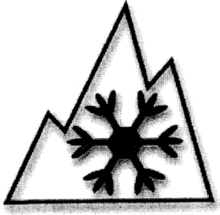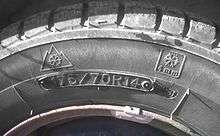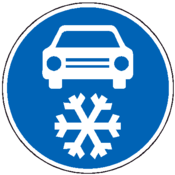Snow tire
Snow tires—often also called winter tires—are tires designed for use in colder weather, snow and ice. Snow chains can be a slower-speed, temporary alternative in snowy conditions. Snow tires have more sipes than summer tires, increasing traction on snow and ice.[1] Tires designed for winter conditions are optimized to drive at temperatures below 7 °C (45 °F).
Studded tires with metal pins that protrude from the tire can greatly reduce skidding and accidents on snow or ice-covered roads. However, the metal studs make contact with the road pavement and eventually cut into the pavement, allowing water to get in. The water can cause road damage and create hydroplaning hazard.[2]
Studded tires

In much of Scandinavia, Canada, and the US, snow tires may have metal studs to improve grip on packed snow or ice, but such tires are prohibited in certain other jurisdictions because of the damage they cause to the road surface.[3] The metal studs are fabricated by encapsulating a hard pin in a softer material base, sometimes called the jacket. The pin is often made of tungsten carbide, a very hard high performance ceramic. The softer base is the part that anchors the stud in the rubber of the tire. As the tire wears with use, the softer base wears so that its surface is at about the same level as the rubber, whereas the hard pin wears so that it continues to protrude from the tire. The pin should protrude at least 1 mm for the tire to function properly.[4] Snow tires do not eliminate skidding on ice and snow, but they greatly reduce risks.[5]
Studdable tires are manufactured with molded holes on the rubber tire tread. Typically, there are 80 to 100 mole holes per tire for stud insertion. The insertion is done by using a special tool that spreads the rubber hole so that a stud jacket can be inserted and the flange at the bottom of the jacket can be fitted nicely to the bottom of the hole. The metal studs come in specific heights to match the depths of the holes molded into the tire tread based on the tread depths. For this reason, stud metals can only be inserted when the tires have not been driven on. A proper stud insertion results in the metal jacket that is flush with the surface of the tire tread having only the pin part that protrudes out.[6]
There is a new development of tires with retractable studs. The concept is to allow the pin part of the stud to be able retractable based on the activation and deactivation with a press of a button by the driver.[7]
Regional symbols and rules
Asia
Japan
All prefectures of Japan, except for the southernmost prefecture of Okinawa, require the motorized vehicles to be fitted with winter tires or tire chains if the road is icy or slushy.[8] If tread grooves of snow tires are worn off for more than 50% of its original depth, tires must be replaced to meet the legal requirements. Drivers will be fined for failing to comply with the snow tire or tire chains requirements.
Expressways and other controlled-access highway have mandatory snow tire restrictions in advance when snowfall is expected. Snow tire checkpoints are often set up in the early winter or on the roads leading to snow country to ensure all vehicles are fitted with appropriate snow tires with good tread depth. In addition, regions prone to severe snow and ice accumulation may require a tire chain to be fitted on top of the snow tires.
Studded tires were popular in Japan until mid 1980s, but some cities have enacted by-laws preventing the use of studded tires in an effort to reduce dust pollution caused by studded tires. In 1987, group of lawyers in Nagano Prefecture have brought up the issue to Environmental Dispute Coordination Commission to ban the sales of studded tires in Nagano Prefecture. In 1988, Environmental Dispute Coordination Commission and major tire manufactures in Japan have agreed to stop the manufacturing and sales of studded tires by March 1991.
Nationwide studded tire restrictions for passenger vehicles came in effect on April 1991, followed by restrictions for commercial trucks in 1993.[9] Studded tires are technically still legal in Japan, but the usage is restricted by environmental law and it is a criminal offence to operate a vehicle fitted with studded tire on dry asphalt or concrete.[9]
North America


In the United States and Canada, a "3PMSF ("Three Peak Mountain Snow Flake")" symbol means that the tire has exceeded the industry requirement from a reference (non-snow) tire.
In the province of Quebec, Canada, winter tires are mandatory on all vehicles registered in the province from Dec 15 to March 15.[10][11]
United States
Many US states permit the use of studded tires in colder months.[12]
British Columbia
Snow tires are only required by law in certain mountainous regions.[13] In these areas, motorists must use Winter tires or carry tire chains. Studded snow tires with studs up to 3.5 mm in length are permitted between October 1 and April 30. Regulations limit the number of studs to fewer than 130 per tire on vehicles weighing less than 4,600 kg.
Alberta
When driving in Banff National Park or Jasper National Park in Alberta, cars are required to have snow tires or tire chains between November 1 to March 31, or any other period during which the road is covered with snow or ice.[14]
Outside of national parks, there are no requirements for winter tires. In extreme conditions, peace officers can shut off roadways and only allow vehicles with sufficient equipment (e.g. winter tires) to drive through. Studded tires and snow chains can only be used if road ways are not damaged, per section 51 of Alberta's Highway Development and Protection Act.[15]
Saskatchewan
There are no requirements for snow tires. Studded tires and chains are allowed.
Manitoba
There are no requirements for snow tires. Studded tires may be used from October 1 to April 30.
Beginning the fall of 2014, Manitoba Public Insurance offers a Winter Tire Financing Program for policy holders. This plan covers the purchase of new winter tires, rims, balancing, etc... for up to a maximum of $2,000.00, financed anywhere from one to a maximum of four years.
Manitoba Public Insurance Winter Tire Program Information Page
As of the Fall of 2014, although a Winter Tire financing program is available by MPIC, winter tires are not yet mandatory.
Ontario
There are no requirements for snow tires. Studded tires may only be used North of Parry Sound and Nipissing districts and only from October 1 to April 30. Northern Ontario residents may use studded tires anywhere in the province during this time. Southern Ontario residents may only use studded tires in Northern Ontario. They could face a $1,000 fine if caught using them in Southern Ontario.
Effective January 1, 2016, there is an insurance discount for using snow tires on your vehicle.[16]
Québec
Winter tires or studded tires must be used from December 15 to March 15. Studded tires may be used from October 15 to May 1.
New Brunswick
There are no requirements for snow tires. Studded tires may be used from October 15 to May 1. School buses must use snow tires.
Nova Scotia
There are no requirements for snow tires. Studded tires may be used from October 15 to May 31.
Prince Edward Island
There are no requirements for snow tires. Studded tires may be used from October 1 to May 31.
Newfoundland
There are no requirements for snow tires. Studded tires may be used from November 1 to May 31.
Northwest Territories
There are no requirements for snow tires. There are no restrictions on studded tires.
Yukon
There are no requirements for snow tires. There are no restrictions on studded tires.
Nunavut
There are no requirements for snow tires. There are no restrictions on studded tires.
Europe

In Europe, requirements for snow tires vary by country: in Andorra, Austria,[17] Czech Republic, Estonia, Finland, Germany, Latvia, Lithuania, Luxembourg,[18] Montenegro,[19] Norway, Romania, Serbia, Slovenia and Sweden, the use of snow tires is a legal requirement during winter months (usually November to mid-April) or if snow or slush is present on road surfaces; failure to comply can result in on-the-spot fines from the police. In Norway, drivers of light vehicles (less than 3,500 kg) are required to use winter tires according to conditions, studded tires are not allowed before November 1 (October 15 in northern parts) unless required by road conditions.[20] Andorra, north and central Italy and Switzerland all recommend snow tires and they are a requirement in many areas. In Bulgaria, Croatia, Czech Republic, Germany, Netherlands, Poland, Romania, Serbia, Slovakia and Slovenia, the use of spiked tires is forbidden. In Switzerland, spiked tires are forbidden on motorways.
In Germany tires with a mud and snow (M+S) marking must be used during winter conditions.[21] [22] M+S tires can be snow tires but all-season tires may also qualify. Studded tires are forbidden for motor vehicles, but allowed for bicycles.
Snow chains fitted to tires are required in Andorra, Austria, France, Germany, Italy, Spain, and Switzerland in certain winter conditions.[23] In Norway, heavy vehicles (3,500 kg or more) are required to bring chains in winter conditions and to use winter tires from November 15 to March 31.[24]
Since July 2008, the Czech Republic uses the Europe-wide road sign requiring the use of snow tires in marked mountainous areas during winter. The duration of obligatory snow tire use was originally November–April (Ordinance 208/2008 Sb.). This was later changed to November–March (Ord. 91/2009 Sb.).
Winter/Snow tyre requirements vary significantly across Europe, with different countries having different statutory requirements[25]
Economic and environmental impact
The studs present in some snow tires come into contact with the road surface, and in certain cases they wear off the roads and cut ruts. Use of these types of snow tires can be costly because of abrasion of road surfaces. In wet weather this can further cause problems when the ruts are filled with water and cause hydroplaning hazard. Furthermore, it can result in creating polluting dust.[26]
References
- ↑ "Winter tyre basics". Tyremen UK. Retrieved 2012-10-24.
- ↑ "Prall Tester - Studded Tyre Wear Test". www.cooper.co.uk. Cooper Research Technology Ltd. Retrieved 1 September 2014.
- ↑ ScienceDaily (6 January 2011). "How Studded Winter Tires May Damage Public Health, as Well as Pavement". Retrieved 26 January 2011.
- ↑ Nordström, Olle (2004). VTI Meddelande 965 - 2004. VTI - Väg- och transportforskningsinstitutet (Report).
- ↑ Gustafsson, M.; et al. (2006). VTI rapport 543 - Effekter av vinterdäck - en kunskapsöversikt. VTI - Väg- och transportforskningsinstitutet (Report).
- ↑ "Studded Tires for Winter Driving". Tirerack.com. Retrieved 24 January 2015.
- ↑ Lloyd, Alex (18 February 2014). "New tire deploys ice-gripping studs with push of a button". Yahoo Auto, Motoramic. Retrieved 24 January 2015.
- ↑ 冬の安全ドライブ事前注意報 Japan Automobile Federation
- 1 2 スパイクタイヤ粉じんの発生の防止に関する法律 e-Gov Laws and Regulations Database
- ↑ http://www.mtq.gouv.qc.ca/portal/page/portal/grand_public_en/vehicules_promenade/securite_routiere/securite_conditions_hivernales/reglement_utilisation_pneus_hiver/
- ↑ http://ca.autoblog.com/2011/11/30/getting-to-know-snow-tire-laws-in-your-province/
- ↑ http://drivinglaws.aaa.com/tag/studded-tires/
- ↑ http://www2.gov.bc.ca/gov/content/transportation/driving-and-cycling/driving/traveller-information/seasonal/winter-driving/winter-tires-and-chains/winter-tire-and-chain-up-routes
- ↑ http://laws-lois.justice.gc.ca/eng/regulations/C.R.C.,_c._1126/page-3.html#h-16
- ↑ http://www.qp.alberta.ca/documents/Acts/h08p5.pdf
- ↑ http://www.fin.gov.on.ca/en/budget/ontariobudgets/2015/ch1f.html#ch1f_18
- ↑ "Winterausrüstungspflicht - was gilt?". ÖAMTC. Retrieved 22 January 2013.
- ↑ "Winter tyres mandatory in Luxembourg" Rezulteo tyres, Retrieved 6 February 2013
- ↑ "Traffic code of Montenegro"
- ↑ http://www.vegvesen.no/Kjoretoy/Sesongbehov/Dekk+og+kjettinger
- ↑ "Driving to Europe in winter". The Automobile Association. Retrieved 16 January 2013.
- ↑ "Winterreifenpflicht bei Glatteis, Schneeglätte, Schneematsch, Eis- oder Reifglätte". Bayerische Polizei. Retrieved 16 January 2013.
- ↑ "Winter tyre and snow chain requirements". UK: The Automobile Association. Retrieved 11 December 2010.
- ↑ Norwegian Public Roads Administration (Statens vegvesen) chain rules published december 2011, accessed September 4, 2013.
- ↑ "European winter tyre laws". Tyremen UK.
- ↑ "Studded Tyre Wear Test". www.cooper.co.uk. Cooper Research Technology Limited. Retrieved 3 September 2014.
